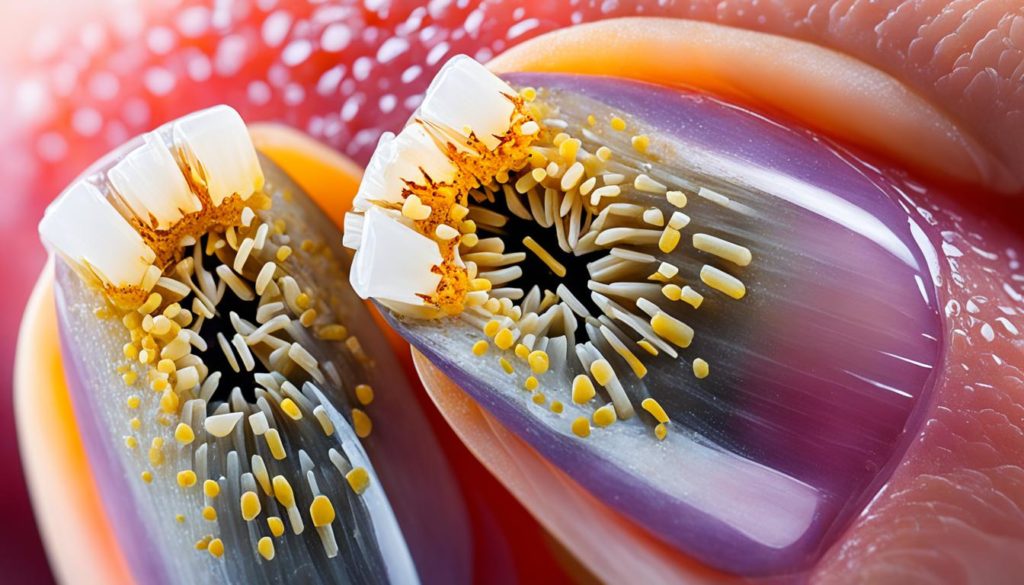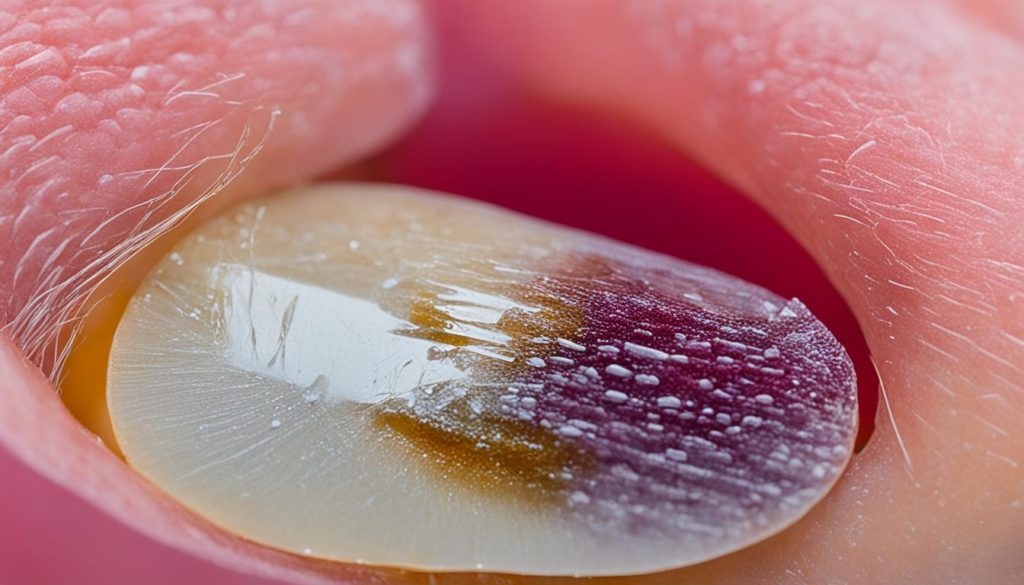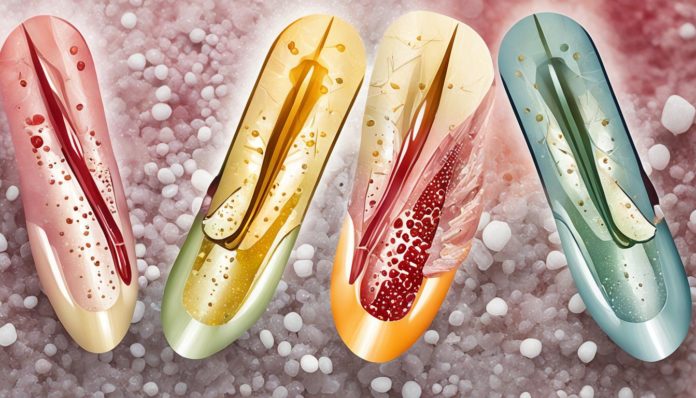Nearly 10% of people in the United States have fungal nail infections, also called onychomycosis. This fact shows how common the problem is. Though many see it as just a beauty issue, it can cause real discomfort. If not treated, it may lead to more serious health issues.
We’re about to explore different ways to treat fungal nail infections. These range from stuff you can buy without a prescription to meds from doctors, and even new laser treatments. No matter if your infection is just starting or it’s been there for a while, knowing effective treatments helps you get back to having healthy nails.
We will look at the top methods to fight and heal fungal nail infections. This means you won’t have to worry about the health and look of your nails anymore.
Key Takeaways
- Fungal nail infections (onychomycosis) affect about 10% of the U.S. population.
- Effective treatments range from topical solutions to advanced laser therapies.
- Timely treatment is crucial to avoid complications associated with untreated infections.
- Understanding the treatment options can significantly improve nail health.
- This guide will provide detailed insights into various fungal nail cure methods.
Understanding Fungal Nail Infections
Fungal nail infections, or onychomycosis, affect many people. They can be stubborn and cause discomfort or even disfigure the nails if not treated.
What is a Fungal Nail Infection?
A fungal nail infection happens when fungi invade the nail. Dermatophytes are usually the culprits, but yeasts and molds can also infect. Toenails are more often affected because shoes create a perfect, damp environment for fungi.
Causes of Fungal Nail Infections
Fungal nail infections come from contact with certain fungi. Moist environments and nail damage also play a role. Places like swimming pools and locker rooms are risky because fungi love warm, wet areas. Bad footwear, poor circulation, and weak immune systems also make infections more likely.

Who is at Risk?
Some people are more likely to get nail fungus. Older adults have a higher risk due to less blood flow and more exposure to fungi. People with diabetes, athlete’s foot, or weak immune systems are also at risk. Wet activities like swimming or using communal baths can up the chances of an infection.
Understanding what causes nail fungus and who’s likely to get it helps. It leads to better prevention and early treatment. This can help keep feet healthy.
Signs and Symptoms of Fungal Nail Infections
It’s essential to know how to spot and understand fungal nail symptoms early. Doing so helps avoid serious problems later on. Let’s talk about the first signs and how things might get worse.
Early Signs to Watch For
Fungal nail infections start off mild but can get bad quickly if ignored. Watch out for these early signs:
- Discoloration: Toenails may turn white, yellow, or brown.
- Texture Changes: The nail may become thick or brittle.
- Unusual Smell: A strange odor might come from the nail.

Progressive Symptoms
If a fungal nail infection isn’t treated, it can get worse. Look out for these signs:
- Nail Deformity: The toenail might look odd or distorted.
- Separation: The nail might lift off the nail bed.
- Pain: It could hurt, especially with shoes on.
- Cracking: The nail edges may crack or crumble.
Knowing fungal nail symptoms and the signs of toenail fungus is powerful. It helps you get treatment fast. Spotting these infections early can lessen their effects and keep your nails healthy.
Topical Treatments for Fungal Nail Infections
Fighting fungal nail infections starts with knowing your topical treatment options. You can apply these treatments right on the infected spots. This method works well for infections that are not too severe.
Over-the-Counter Solutions
Many start with over-the-counter options like creams, gels, and lacquers. Products from brands like Lotrimin and Lamisil are easy to find. They have ingredients like clotrimazole or terbinafine that kill the fungus.
Prescription Medications
For tough or serious cases, prescription meds may be needed. You might get prescribed Penlac (ciclopirox) nail lacquer or Jublia (efinaconazole). These are stronger and better at reaching the fungus under the nail.
Application Tips for Topical Treatments
Knowing how to apply antifungal treatments is crucial. Here are some pointers:
- Follow the instructions closely, usually applying once or twice a day.
- Make sure the nail is clean and dry before applying anything.
- Use an emery board to file the nail. This helps the medicine work better.
- Keep using the treatment for as long as recommended, which could be weeks or months.
Following these tips can make a big difference. Whether you choose an over-the-counter or a prescription option, being patient and consistent is important. That’s how you’ll see the best results in fighting nail fungus.
Oral Medications: Pros and Cons
Looking for a way to fight a tough fungal nail infection? Oral antifungal medications can help. These drugs work from the inside out. This makes them more effective than creams or ointments. But, it’s important to consider both the good and the bad sides before deciding.
Effective Medications
There are good oral treatments for fungal nail infections. Terbinafine, Itraconazole, and Fluconazole are some of the top picks. They attack the infection thoroughly. Usually, you’ll need to take them for a few weeks to get the best results.
Possible Side Effects
Oral antifungal medications work well, but they have risks. You might get an upset stomach, headaches, or skin rashes. In rare cases, these drugs can cause liver or heart issues. So, talking with a doctor first is key.
Important Considerations
Thinking about systemic treatment for onychomycosis? Checking your health and any other meds you’re taking is crucial. You might also need regular tests to make sure the treatment is safe and working.
- Evaluate overall health status
- Consider existing medical conditions
- Monitor for potential medication interactions
| Medication | Advantages | Disadvantages |
|---|---|---|
| Terbinafine | Highly effective, shorter treatment duration | Possible liver toxicity, gastrointestinal issues |
| Itraconazole | Effective for various fungal infections | Monitor for heart and liver issues, requires longer usage |
| Fluconazole | Good alternative for those who can’t use Terbinafine | Drug interactions, risk of liver problems |
Home Remedies for Toenail Fungus
People often turn to nature for toenail fungus treatments. These methods are praised for being gentle with fewer side effects. We’ll explore effective natural treatments, the power of essential oils, and safety tips.
Naturally Derived Treatments
Solutions from nature are a popular choice. Vinegar, tea tree oil, and garlic are famous for fighting fungus. These treatments aid in healing and improving nail health. It’s important to stay patient, as results take time.
Essential Oils and Their Benefits
Essential oils are widely used for fungal infections because of their strong properties. Tea tree, oregano, and lavender oils are effective against toenail fungus. They can reach deep, combating fungus at its origin and helping to stop it from coming back. It’s key to mix these oils with another to reduce skin irritation.
Precautions when Using Home Remedies
Home treatments work well, but safety is a must. Do a test first to avoid allergies. Keep things clean, dry, and personal to stop fungus spread. When applying essential oils, always dilute and use them sparingly.
Laser Treatment for Fungal Nail Infections
Medical technology has made great strides, offering new ways to treat tough fungal nail infections. Laser therapy stands out as a leading option. It is known for its efficiency and ease.
How Laser Treatment Works
Laser therapy tackles nail fungus with focused beams of light. These beams go through the nail to destroy the fungi causing the infection. It’s a safe process that doesn’t harm nearby skin.
Effectiveness and Success Rates
Studies show laser treatments hold promise for beating fungal infections. Patients often see a big drop in infection and clearer nails. Yet, success varies by the infection’s seriousness and patient follow-up.
Costs and Accessibility
The price of laser treatments for fungal nails changes based on location and clinic fees. Costs range from $500 to $1,200 for multiple sessions. Despite the high price, many think the results are worth it. Laser therapy is becoming more accessible, with clinics across the country offering it.
Preventing Fungal Nail Infections
To avoid fungal nail infections, it’s key to take care of your feet, wear the right shoes, and be careful in public areas. By doing these, you can greatly cut down your risk of getting fungal nail infections. This keeps your feet healthy. Here are some tips to prevent these infections.
Hygiene Tips
Good foot hygiene is crucial for preventing fungal nail infections. Make sure to clean and dry your feet well daily, especially after being wet. Also, using antifungal powder helps keep your feet dry. Plus, trim your nails straight across and keep them short to lessen infection risks.
Footwear and Sock Choices
Choosing the right shoes and socks is vital in avoiding fungal nail infections. Go for shoes made from materials like leather or mesh. These allow your feet to breathe and lower moisture. For socks, pick ones that move moisture away from your feet. Also, don’t wear the same shoes daily. This lets them dry out properly between wears.
Avoiding Public Risks
Places like gyms, pools, and shared showers are often where fungal infections spread. Wearing flip-flops or shower shoes in these places can help keep you safe. They minimize your contact with germs. Also, always wash and dry your feet well after using public spaces to get rid of any germs.
The Role of Diet in Treating Nail Fungus
Eating right is key to fighting fungal nail infections. Including certain foods, staying hydrated, and taking supplements helps. These steps boost your body’s defenses and nail health.
Foods that Fight Infections
Eat foods full of antioxidants, vitamins, and minerals. They help fight off infections. Here are some great choices:
- Garlic: Known for its antifungal properties.
- Yogurt: Contains probiotics that strengthen the immune system.
- Leafy Greens: Packed with vitamins and minerals like Vitamin C and zinc.
- Fish: Rich in omega-3 fatty acids, which reduce inflammation.
- Almonds: High in biotin, which supports nail strength.
Supplements and Their Benefits
If your diet falls short, supplements can help. Consider adding these:
- Biotin: Enhances nail thickness and reduces brittle nails.
- Vitamin E: Improves circulation and supports nail growth.
- Probiotics: Boosts overall immunity, making it harder for infections to settle in.
- Omega-3 Fatty Acids: Fights inflammation and promotes overall nail health.
Hydration and Its Impact
Staying hydrated is crucial for nail health. It makes your nails flexible and prevents cracks. This stops fungi from growing. Drink lots of water every day. Also, eat hydrating foods like cucumbers, oranges, and melons.
Right diet, supplements, and staying hydrated are best against fungal nail infections. Your nails will be healthier thanks to your effort.
When to See a Healthcare Professional
Knowing when to see a doctor for nail fungus is key to stopping it from getting worse. It’s vital to know when you need professional help.
Signs of Serious Infections
If you ignore early warnings, nail fungus can lead to big problems. Look out for these symptoms that mean you should see a specialist:
- Persistent pain in the affected nail
- Swelling and redness around the nail bed
- Significant changes in nail color and texture
- Development of thickened or distorted nails
- Signs of an infection spreading to other nails or skin
Choosing the Right Specialist
Finding the right doctor for severe nail fungus is crucial. Consider these tips:
- Look for a specialist with lots of experience in treating nail fungus
- Check for board certification and links to well-known medical boards
- Ask for recommendations or read reviews from other patients
Getting the right diagnosis and treatment from a specialist can greatly improve your nail health.
Case Studies and Personal Stories
Looking into personal journeys with nail fungus offers hope and insight. Through these stories of onychomycosis, we learn about various treatments. Each story highlights different effective approaches.
An athlete’s story shows his struggle with nail fungus from locker rooms and pools. Despite many tries with store-bought treatments, only a doctor’s prescription helped him recover. His journey stresses the need for expert advice.
A healthcare worker found a solution in natural remedies. She combined essential oils with strong hygiene and tracked her improvement. Over months, she achieved clear nails. Her story motivates others to try alternative options.
A professional chose laser treatment for its speed and effectiveness. His successful recovery adds to the growing success stories. It shows how modern treatments can offer quick and lasting solutions.
| Profiles | Treatments Tried | Outcome |
|---|---|---|
| Athlete | OTC, Oral Medication | Significant improvement |
| Healthcare Worker | Natural Remedies | Clear nails over several months |
| Professional | Laser Treatment | Quick and effective recovery |
These varied success stories teach us the importance of a suited treatment plan. They also show the importance of not giving up and speaking to a doctor. This is key to beating nail fungus.
Conclusion
Beating fungal nail infections means understanding, treating, and preventing them. We’ve looked at their causes, risks, and early signs in this article. Knowing these basics is the first step toward managing and treating them effectively.
There are many ways to fight these infections, from creams and pills to natural cures and lasers. Each method has its pros and cons. It’s all about finding what works best for you. Keeping your nails clean and choosing the right shoes and socks are crucial steps to keep nails healthy.
Use the knowledge shared here to tackle fungal nail infections head-on. Whether changing your diet, seeing doctors, or trying new treatments, the aim is to get your nails healthy again. Let’s tackle fungal nail infections together and get the healthy nails we all want. With the proper info and tools, beating fungal nail infections is possible. Remember, staying consistent with care and prevention is the secret to lasting nail health.
FAQ
What is a Fungal Nail Infection?
A fungal nail infection, or onychomycosis, happens when fungi infest the nail. It turns the nail discolored, thickened, and brittle.
What are common causes of Fungal Nail Infections?
These infections stem from various fungi, including dermatophytes and yeasts like Candida. Tight shoes, poor foot care, and a weak immune system contribute to the problem.
Who is at risk of developing Fungal Nail Infections?
Risk groups include those with diabetes, weakened immune systems, or poor circulation. Also, older adults and people who frequently use communal areas are prone.
What are the early signs of a Fungal Nail Infection?
Look for white or yellow spots under the nail’s tip. Early stages also show slight nail discoloration and minor thickening.
What are the progressive symptoms of Fungal Nail Infections?
Symptoms worsen to increased discoloration and thickening. Nails may become distorted, crumbly, and could even detach from the nail bed.
What over-the-counter solutions are available for Fungal Nail Infections?
Available options include antifungal creams, ointments, and medicated nail lacquers. Products like terbinafine and ciclopirox are common choices.
What prescription medications are available for Fungal Nail Infections?
Stronger treatments available by prescription include efinaconazole (topical) and oral options like terbinafine and itraconazole.
How should topical treatments for Fungal Nail Infections be applied?
Follow the instructions well. Keep nails clean and dry before use. Apply consistently, usually once or twice a day, until the infection clears.
What are the pros and cons of oral medications for Fungal Nail Infections?
Oral meds are effective but can cause liver issues or stomach problems. They’re faster than creams but need monitoring by a doctor.
What are some naturally derived treatments for toenail fungus?
Some natural remedies include tea tree oil, oregano oil, vinegar soaks, and garlic. These have antifungal properties for mild cases.
What precautions should be taken when using home remedies for toenail fungus?
Watch for allergies or bad reactions. Always dilute oils. Apply consistently and watch for signs of worsening that need a doctor’s care.
How does laser treatment for Fungal Nail Infections work?
Laser treatment targets the fungus with light, not harming the surrounding skin. It’s non-invasive but often needs several visits.
Are there preventive measures for Fungal Nail Infections?
Preventing infections involves good foot hygiene, changing socks often, choosing breathable shoes, and not going barefoot in public places.
What role does diet play in treating Nail Fungus?
Eating foods with antifungal properties, like garlic and coconut oil, supports your immune system. Stay well-hydrated for healthy nails too.
When should I see a healthcare professional for a Fungal Nail Infection?
See a doctor if there’s major discomfort, spreading, nail detachment, or if simple treatments don’t work. Important for those with conditions like diabetes.
What can I expect from a healthcare consultation regarding Fungal Nail Infections?
The provider will diagnose and recommend treatments, which might include medications, laser, or other methods. They’ll also help with prevention tips.


